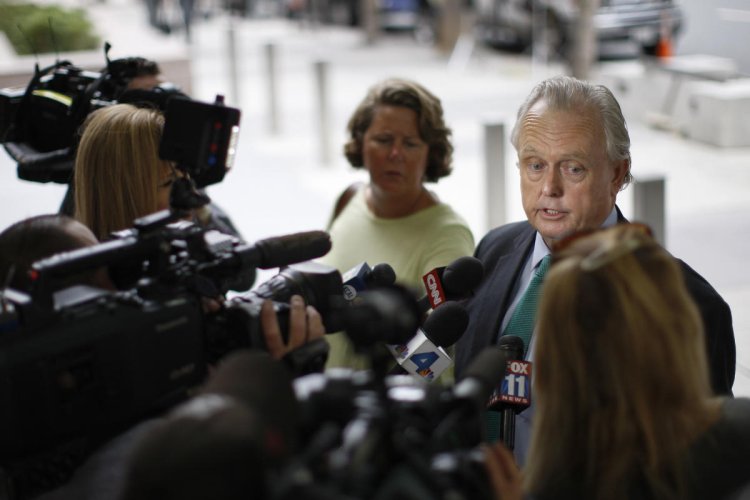Orlando Museum of Art lawsuit defendant: ‘I intend to be their worst nightmare’
David McNew/Orlando Sentinel/TNSPierce O’Donnell, one of the owners of the purported Basquiat art seized from the Orlando Museum of Art last June, has said he will vigorously defend the institution’s lawsuit against him — characterizing the suit as a misguided attempt by an unworldly organization trying to deflect attention away from its own shortcomings.“I intend to be their worst nightmare,” O’Donnell told the Orlando Sentinel in a phone interview this week. “I don’t appreciate their efforts to sully my reputation.”Aaron De Groft, the museum director who arranged the exhibit and was subsequently fired, is also named in the lawsuit, which was filed in Orange County circuit court on Aug. 14. He said the case was without merit.“This is not as it seems,” he told the Sentinel in a text message. “This [is] an attempt to smear me when I was doing my job in bringing an art exhibition to our community.”Orlando Museum of Art sues ex-director, others over ‘Basquiat’ artAfter months of silence


Pierce O’Donnell, one of the owners of the purported Basquiat art seized from the Orlando Museum of Art last June, has said he will vigorously defend the institution’s lawsuit against him — characterizing the suit as a misguided attempt by an unworldly organization trying to deflect attention away from its own shortcomings.
“I intend to be their worst nightmare,” O’Donnell told the Orlando Sentinel in a phone interview this week. “I don’t appreciate their efforts to sully my reputation.”
Aaron De Groft, the museum director who arranged the exhibit and was subsequently fired, is also named in the lawsuit, which was filed in Orange County circuit court on Aug. 14. He said the case was without merit.
“This is not as it seems,” he told the Sentinel in a text message. “This [is] an attempt to smear me when I was doing my job in bringing an art exhibition to our community.”
Orlando Museum of Art sues ex-director, others over ‘Basquiat’ art
After months of silence about an internal investigation into the Basquiat affair conducted by the Akerman law firm, the museum on Monday filed a lawsuit against De Groft, O’Donnell and other owners of the artwork that hung in its “Heroes & Monsters: Jean-Michel Basquiat” exhibit. The suit requests a jury trial and seeks unspecified damages.
Paintings by Basquiat, an acclaimed contemporary artist who died in 1988, sell for millions of dollars. But the FBI seized the “Heroes & Monsters” works on view at the museum as part of an ongoing fraud investigation.
California auctioneer Michael Barzman later told the law-enforcement agency he helped create some of the works years after Basquiat’s death. As part of a deal, he pleaded guilty to lying to the FBI in earlier statements. At his sentencing on Aug. 18 in Los Angeles, he avoided jail time but was given three years of probation, ordered to complete 500 hours of community service, and pay a $500 fine.
O’Donnell, a high-profile attorney based in Los Angeles, said the auctioneer’s story of faking the artworks is not to be believed.
“Michael Barzman is lying through his teeth,” he said. “ I’m 100% sure that he’s lying.”
His comments echoed those of De Groft, who earlier this year told Vanity Fair magazine that Barzman’s plea agreement with the FBI was a “totally sweet-deal cover-up.”
Both men emphatically denied any wrongdoing; the museum accuses them of fraud, breach of contract and conspiracy.
Auctioneer admits to helping create fakes shown as Basquiats in Orlando
In De Groft’s case, the museum alleges he neglected his fiduciary responsibility to the organization by trying to personally profit from an eventual sale of the artwork, in collusion with O’Donnell.
“I did nothing wrong and had no agreements to sell art I did not own,” De Groft told the Sentinel. “How would I do that?”
“I utterly deny the accusation I was in some kind of conspiracy with Dr. DeGroft,” O’Donnell said.
The lawsuit demonstrates a “lack of sophistication” and “lack of knowledge” about the workings of the art world, O’Donnell said: “The rhetoric in that complaint is so over the top, you’d think we were all a bunch of ax murderers.”
He added the museum’s lack of understanding of the art world’s wheeling and dealing made them misconstrue friendly and jocular emails and texts.
“Much of what they allege there is normalcy,” he said. “They are trying to make things sinister that aren’t.”
While the museum’s suit emphasizes how the “Heroes & Monsters” exhibition cost it money and damaged its reputation, O’Donnell said the suit is really an exercise in deflection.
“It’s a misguided effort to cover their tracks,” he said. “They have a lot of explaining to do about how they’ve made mistakes. … The motivation of the museum is to lash out when they should do some serious self-reflection.”
The other defendants in the lawsuit are John Leo Mangan III, also known as Lee Mangan or Leo Mangan; William Michael Force, also known as Michael William Force; Taryn Burns; Basquiat Venice Collection Group, a California joint venture; MJL Family Trust LLC, a Colorado limited liability company; and Richard LiPuma. All have an ownership stake in the disputed artwork.
Orlando Museum of Art ex-director: Basquiat plea deal a ‘cover-up’
O’Donnell said the owners were excited over the chance to display the works in Orlando: “I thought it was a wonderful breakthrough that this respectable museum wanted to show our art. … We were thrilled — over the moon — how could we not be thrilled? It was an important validation of the art.”
The excitement was heightened because the two most common ways to give artwork legitimacy — a listing in a “catalogue raisonné” or certification by an authentication committee — were not available to the owners.
A catalogue raisonné is a comprehensive and vetted published work detailing all an artist’s known creations. A definitive Basquiat catalog had been published in 2010 — two years before O’Donnell says he became aware of the works that would end up in Orlando.
The Authentication Committee of the Estate of Jean-Michel Basquiat shut down in 2012 after reviewing more than 2,000 works over 18 years.
The lawsuit claims the museum’s staff members were intimidated by De Groft and feared for their jobs, but O’Donnell questioned why the museum’s staff didn’t go straight to the board of trustees with concerns, or why the board didn’t simply halt the exhibition if there were questions after learning about the FBI investigation.
‘Basquiat fiasco’ at Orlando Museum of Art: Ex-trustees say they were kept in the dark on FBI
Former trustees have previously told the Orlando Sentinel that then-chairwoman Cynthia Brumback kept them in the dark about the FBI’s subpoenas served on the museum.
“The museum had every piece of information, all the independent reviews. There was no attempt to con or defraud them,” O’Donnell said. “If they had problems with this art they should have spoken up. They should not have exhibited it.”
And he dismissed the idea that his actions to try to sell the paintings were improper.
“The operation, of course, is to sell them,” he said.
An email exhibited as part of the museum’s lawsuit shows there was interest from potential buyers.
In a March 22, 2022, message from Mangan to O’Donnell, in which De Groft was copied, he asks: “How are you pitching this? I am getting pressed to give the offering price from both the Samsung and Hyundai family’s [sic]. What is that price?”
The museum presented the email to bolster its claim that De Groft was involved in selling the art, counter to his employment obligations.
Orlando museum director: ‘Absolutely no doubt’ Basquiats are genuine
While O’Donnell has described the works’ convoluted origin story — sold to a screenwriter, left to languish in a storage locker, discarded and then rediscovered — as an “improbable odyssey,” he still stands by them, despite questions about anachronistic shipping labels and other odd details.
“In good faith I thought they were authentic,” he said. “I still think they’re authentic.”
And, in the face of the lawsuit calling his relationship with De Groft “bizarrely close,” he defended the museum’s former director.
“Dr. Aaron De Groft is a decent, honest art historian,” O’Donnell said. “He’s a true believer. He’s a direct victim of all of this. It’s unfortunate.”
De Groft told the Sentinel that the “Heroes & Monsters” exhibit came about solely because he was working to meet his job responsibilities.
“I was tasked by the board to bring the best exhibitions to the OMA, an international museum in a global city,” he said.
O’Donnell indicated a more formal response to the lawsuit — a “counterpunch” — would be coming “in a short period of time,” and he was confident he and the other defendants would be vindicated.
“I’m comfortable that we did everything right,” he said. “We gave them in good faith art we believed authentic.”
Follow me at facebook.com/matthew.j.palm or email me at [email protected]. Find more arts news and reviews at orlandosentinel.com/arts, and go to orlandosentinel.com/theater for theater news and reviews.
What's Your Reaction?













